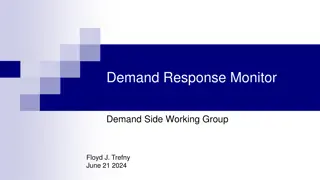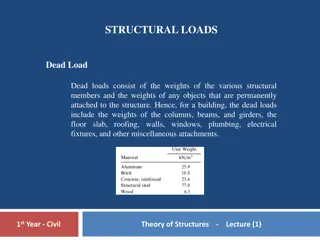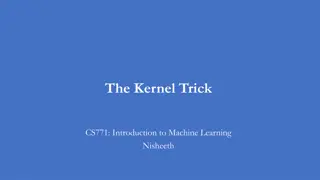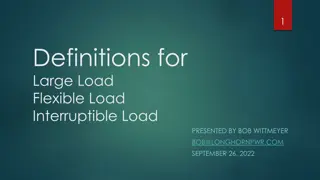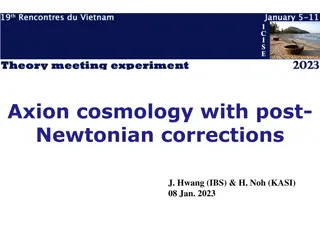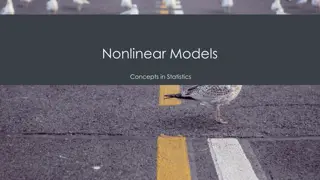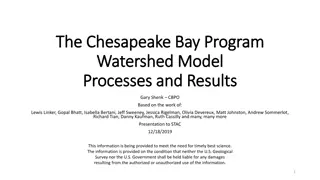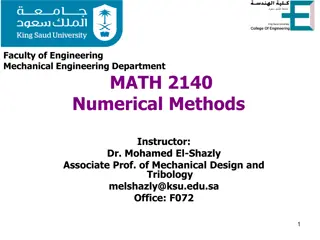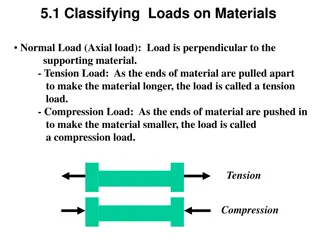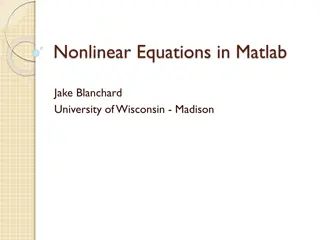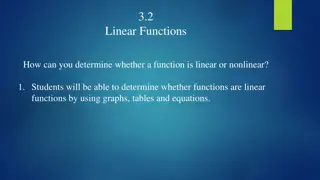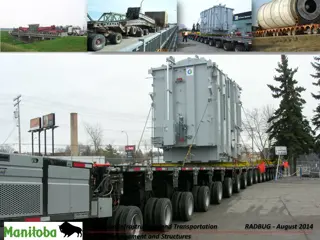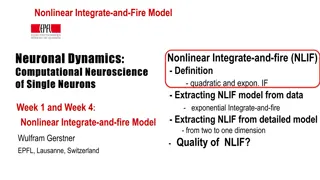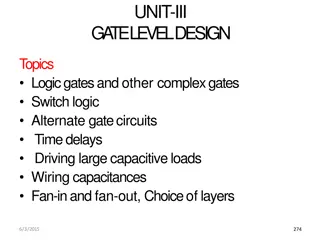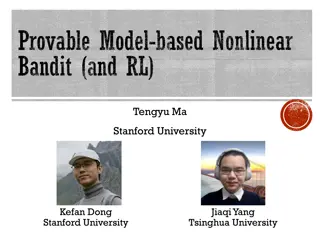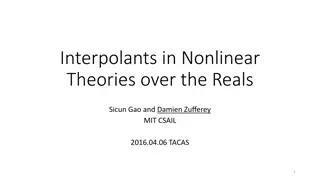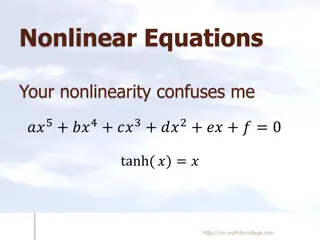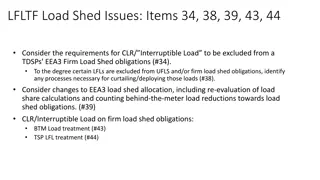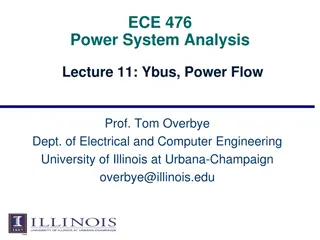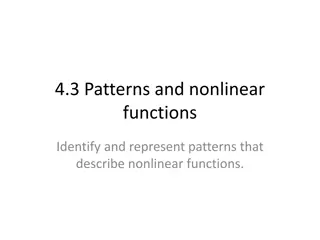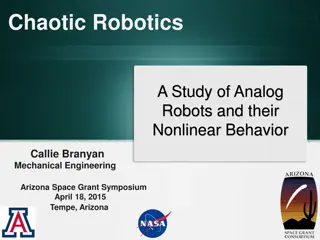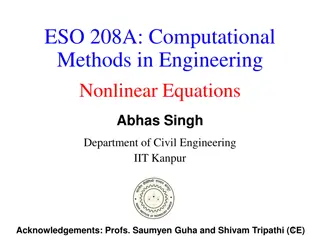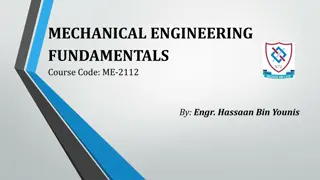Floyd Trefny Proposal for Real-Time Settlement of Price-Sensitive Flexible Loads
The Floyd Trefny proposal aims to enhance real-time settlement for loads responsive to prices but not registered as controllable load resources. It suggests unique pricing based on Load Zone prices, impacting revenue allocation and benefiting responsive loads while possibly increasing costs for othe
3 views • 10 slides
Nonlinear Relationships in Econometrics
Discover the complexities of nonlinear relationships through polynomials, dummy variables, and interactions between continuous variables in econometrics. Delve into cost and product curves, average and marginal cost curves, and their implications in economic analysis. Understand the application of d
3 views • 34 slides
Enhancing ERCOT's Capacity Assessment with Demand Response Monitoring
Demand response in ERCOT has been increasing, with forecasts of continued growth. The system operator can identify MW peaks by analyzing total ERCOT load data. A proposed Demand Response Monitor would assist in predicting future capacity needs based on responses from loads like LMP energy prices and
0 views • 7 slides
Bridge Loading and Rating
Bridges are subjected to various types of loads such as dead load, live load, and other loads like wind and temperature effects. Dead load consists of the bridge's self-weight, while live load includes temporary moving loads. Bridges are rated to determine their load carrying capacity, especially in
0 views • 21 slides
Structural Loads in Civil Engineering
Structural loads in civil engineering encompass dead loads from permanent structures, live loads that vary in magnitude and location, impact factors influencing rapid load application, wind loads due to blocked airflow, earthquake loads, and hydrostatic pressures for water-retaining structures. Thes
1 views • 6 slides
The Power of Nonlinear Models in Machine Learning
Delve into the limitations of linear models for handling nonlinear patterns in machine learning. Explore how nonlinear problems can be effectively addressed by mapping inputs to higher-dimensional spaces, enabling linear models to make accurate predictions. Discover the significance of feature mappi
2 views • 15 slides
Definitions and Classifications for Large, Flexible, and Interruptible Loads in the Energy Industry
Exploring the definitions, requirements, and benefits of large, flexible, and interruptible loads in ERCOT processes. Learn why these classifications are necessary, how they differ from traditional loads, and the implications for grid reliability and system resiliency.
3 views • 9 slides
Multi-Criteria Test Suite Minimization with Integer Nonlinear Programming
The study introduces a method for minimizing test suites using Integer Nonlinear Programming. It addresses regression testing challenges, such as managing large numbers of test cases, through Multi-Criteria Test Suite Minimization (MCTSM). The research explores the application of Integer Programming
3 views • 34 slides
Axion Cosmology with Post-Newtonian Corrections
Exploring axion cosmology with post-Newtonian corrections, this study delves into linear density perturbations for dust, the role of axion as a cold dark matter candidate, and fully nonlinear perturbation formulations. It addresses continuity, momentum conservation, and quantum stress to identify ke
0 views • 22 slides
Nonlinear Models in Statistics
Nonlinear models in statistics focus on exploring nonlinear relationships between quantitative variables. This involves defining exponential growth and decay, analyzing population data trends like the dramatic turnaround of bald eagles after the ban on DDT, and determining when linear models may not
1 views • 21 slides
Chesapeake Bay Program Watershed Model Overview
The Chesapeake Bay Program's Watershed Model, presented to STAC in December 2019, provides insights on long-term average pollutant loads and land use dynamics in the Chesapeake Bay watershed. The model incorporates inputs such as land use acres, BMPs, and delivery mechanisms to estimate pollutant lo
0 views • 41 slides
Nonlinear Curve Fitting Techniques in Engineering
Utilizing nonlinear curve fitting techniques is crucial in engineering to analyze data relationships that are not linear. This involves transforming nonlinear equations into linear form for regression analysis, as demonstrated in examples and methods such as polynomial interpolation and exponential
0 views • 18 slides
Loads, Stress, and Strain in Materials Engineering
This content covers the classification of loads on materials including normal, shear, and torsion loads, as well as thermal loads. It further explains stress as the load per unit area and strain as the ratio of elongation of a material to its original length. The stress-strain diagram, along with th
1 views • 51 slides
Solving Nonlinear Equations in Matlab: A Comprehensive Guide
Explore the process of solving nonlinear algebraic equations using fzero and fsolve commands in Matlab. Understand the potential for no solution or multiple solutions, and learn how to convert equations into functions, define the functions, call the solver, and run the full code to find the roots of
0 views • 9 slides
Neural Network Control for Seismometer Temperature Stabilization
Utilizing neural networks, this project aims to enhance seismometer temperature stabilization by implementing nonlinear control to address system nonlinearities. The goal is to improve control performance, decrease overshoot, and allow adaptability to unpredictable parameters. The implementation of
0 views • 24 slides
Determining Linearity of Functions Through Graphs, Tables, and Equations
Students learn to distinguish between linear and nonlinear functions by examining graphs, tables, and equations. Linear functions exhibit constant rates of change, represented by straight lines, while nonlinear functions lack a constant rate of change, leading to curved or non-linear graph shapes. B
0 views • 11 slides
Innovative Overload Permitting for Heavy Loads in Manitoba
Increased demand for hauling heavier loads in Manitoba has led to the development of innovative overload permitting processes by the Department of Infrastructure and Transportation. Using advanced design and load rating specifications, they approved a superload weighing 363,250 kg (800,830 lbs) for
0 views • 34 slides
Nonlinear Integrate-and-Fire Models in Neuronal Dynamics
Exploring the Nonlinear Integrate-and-Fire (NLIF) model in computational neuroscience, including its definition, the quadratic and exponential IF variations, and methods for extracting NLIF models from data and detailed neuronal models. Gain insights into the complex dynamics of single neurons throu
0 views • 32 slides
Logic Gates and Large Load Driving in GA-TE Level Design
In GA-TE Level Design, the topics cover logic gates, complex gates, switch logic, gate circuits, timedelays, driving capacitive loads, wiring capacitances, fan-in and fan-out, choice of layers, NMOS and PMOS gate constructions, parasitics and performance impact, strategies for driving large loads, a
2 views • 21 slides
Challenges in Model-Based Nonlinear Bandit and Reinforcement Learning
Delving into advanced topics of provable model-based nonlinear bandit and reinforcement learning, this content explores theories, complexities, and state-of-the-art analyses in deep reinforcement learning and neural net approximation. It highlights the difficulty of statistical learning with even on
0 views • 23 slides
Nonlinear Proton Dynamics in the IOTA Ring: Advancements in Beam Acceleration
Probing the frontier of proton acceleration, this research delves into nonlinear dynamics within the IOTA ring, showcasing integrable optics and innovative technologies. Collaborations with Fermilab drive advancements in accelerator science, supported by the US DOE. The study explores variational as
2 views • 21 slides
Interpolants in Nonlinear Theories: A Study in Real Numbers
Explore the application of interpolants in nonlinear theories over the real numbers, delving into topics such as reasoning about continuous formulae, Craig interpolation, and branch-and-prune strategies. Discover how nonlinear theories can be both undecidable and decidable with perturbations, captur
0 views • 20 slides
Solving Nonlinear Equations in Engineering Problems
Explore practical applications of solving nonlinear equations in engineering scenarios, including finding submersion depth of floating balls, determining fluid temperatures, and calculating mast height for structural stability. Engage with examples and visuals to enhance your understanding of nonlin
0 views • 38 slides
Nonlinear Optical Processes in Semiconductors
Exploring the complexities of nonlinear optics in the perturbative and non-perturbative regimes, this research delves into the generation of harmonics, optical Kerr effects, and extreme nonlinear optical phenomena utilizing phase-controlled electromagnetic pulses. The work also investigates the inte
1 views • 15 slides
Linear and Nonlinear Functions in Mathematics
Explore the concepts of linear and nonlinear functions in mathematics through identifying linear and nonlinear functions from graphs, understanding the characteristics of linear functions, and identifying linear functions from tables. Learn about the constant rate of change, slope, and how to determ
0 views • 49 slides
Chloroprene Rubber Compression Test Using COMSOL
Elastomers and biological materials exhibit strain rate dependent mechanical behavior and hysteresis when subjected to cyclical loads. This example demonstrates the use of the Polymer Viscoplasticity feature in the Nonlinear Structural Materials Module for modeling such phenomena using the Bergstrom
0 views • 8 slides
Harmonics in Modern Electrical Loads
Explore the impact of harmonic content in modern electrical loads due to nonlinear characteristics, decomposition into Fourier series, effects on power systems, regulatory standards, and analysis of power supply systems. Discover the evolution from linear to nonlinear loads driven by semiconductor a
0 views • 42 slides
Issues and Requirements for CLR/Interruptible Load Shed Exclusions
Considerations for excluding CLR/Interruptible loads from TDSPs' EEA3 Firm Load Shed obligations, processes for curtailing/deploying those loads, changes to load shed allocation, and treatment of interruptible loads. Explore the challenge of Load Shed Allocation and foundational assumptions guiding
0 views • 7 slides
Understanding Nonlinear Media Propagation
Explore the microscopic description of nonlinearity in nonlinear media, including anharmonic oscillators and Lorentz force effects. See how strong incident linearly polarized fields affect electron trajectories and discover the equations governing displacements in x and z directions in a simple case
0 views • 67 slides
Ultrafast Nonlinear Optics High Harmonic Generation Project
Explore the project on high harmonic generation in ultrfast nonlinear optics, aiming for 5th harmonic generation using the Kansas Light Source laser. Learn about harmonic frequencies, design components like Barium Borate and Argon Gas, and achieve a 3rd harmonic light with 5% power conversion effici
0 views • 6 slides
Understanding Linear and Nonlinear Oscillators in Classical Mechanics
Explore the concepts of linear and nonlinear oscillators, derivatives, differential equations, and harmonic oscillators in classical mechanics and electromagnetism. Learn about the linearization of differential equations, Taylor expansion of forces, and methods of solving harmonic oscillators. Dive
0 views • 12 slides
Enhanced Steady-State Simulation of Nonlinear Integrated Microelectronic Devices and Circuits
Explore the enhanced steady-state simulation of nonlinear devices and circuits in this undergraduate research project. Learn about modified nodal analysis, nonlinear device models, and numerical results for efficient electronic design simulation and automation.
0 views • 18 slides
Power System Analysis and Linear/Nonlinear Elements Overview
Learn about power flow analysis, linear vs. nonlinear systems, linear and nonlinear power system elements, and the challenges of solving nonlinear problems in power systems. Understand how linear elements can be analyzed using superposition, while nonlinear elements require iterative approaches. Exp
0 views • 32 slides
Understanding Nonlinear Functions and Patterns in Mathematics
Discover and analyze patterns in nonlinear functions, interpreting graphs of linear and nonlinear functions, and writing rules to describe nonlinear functions. Explore relationships between variables in various mathematical contexts with practical examples and visual representations.
0 views • 9 slides
Exploring Analog Robotics and Nonlinear Behavior in Chaotic Robotics Study
Dive into the world of analog robotics and nonlinear behavior with a study on chaotic robotics by Callie Branyan. The research aims to develop an analog circuit showcasing nonlinear behavior for enhanced performance over digital counterparts and creating more resilient robots for autonomous explorat
0 views • 14 slides
Computational Methods in Engineering: Nonlinear Equations Analysis
Explore the world of nonlinear equations in engineering through methods like Graphical, Bracketing, and Bisection methods. Understand the principles behind finding roots of nonlinear equations efficiently.
0 views • 14 slides
Understanding Bridge Loading and Rating
Learn about the classification of bridge loads, including dead loads, live loads, and other loads. Discover the importance of rating bridges to determine their load-carrying capacity in today's truck configurations.
0 views • 20 slides
Exploring Patterns and Nonlinear Functions
Discover the concept of nonlinear functions through classifying functions as linear or nonlinear based on different scenarios and graphs, and determine linearity with given data points. Gain insights into how functions behave and understand their graphical representations.
0 views • 6 slides
Understanding Patterns and Nonlinear Functions
Explore the classification of functions as linear or nonlinear, representation of patterns, and writing rules for describing nonlinear functions in this educational content. Graphs and tables are used to illustrate concepts effectively.
0 views • 8 slides
Understanding Mechanical Engineering Fundamentals - Loads, Stress, and Strain
Dive into the fundamentals of mechanical engineering, exploring the concepts of loads, stress, and strain. Learn about different types of loads, unit stress, unit strain, tensile and compressive stress and strain, shear stress and strain, as well as properties like Young's Modulus and Shear Modulus.
0 views • 9 slides


